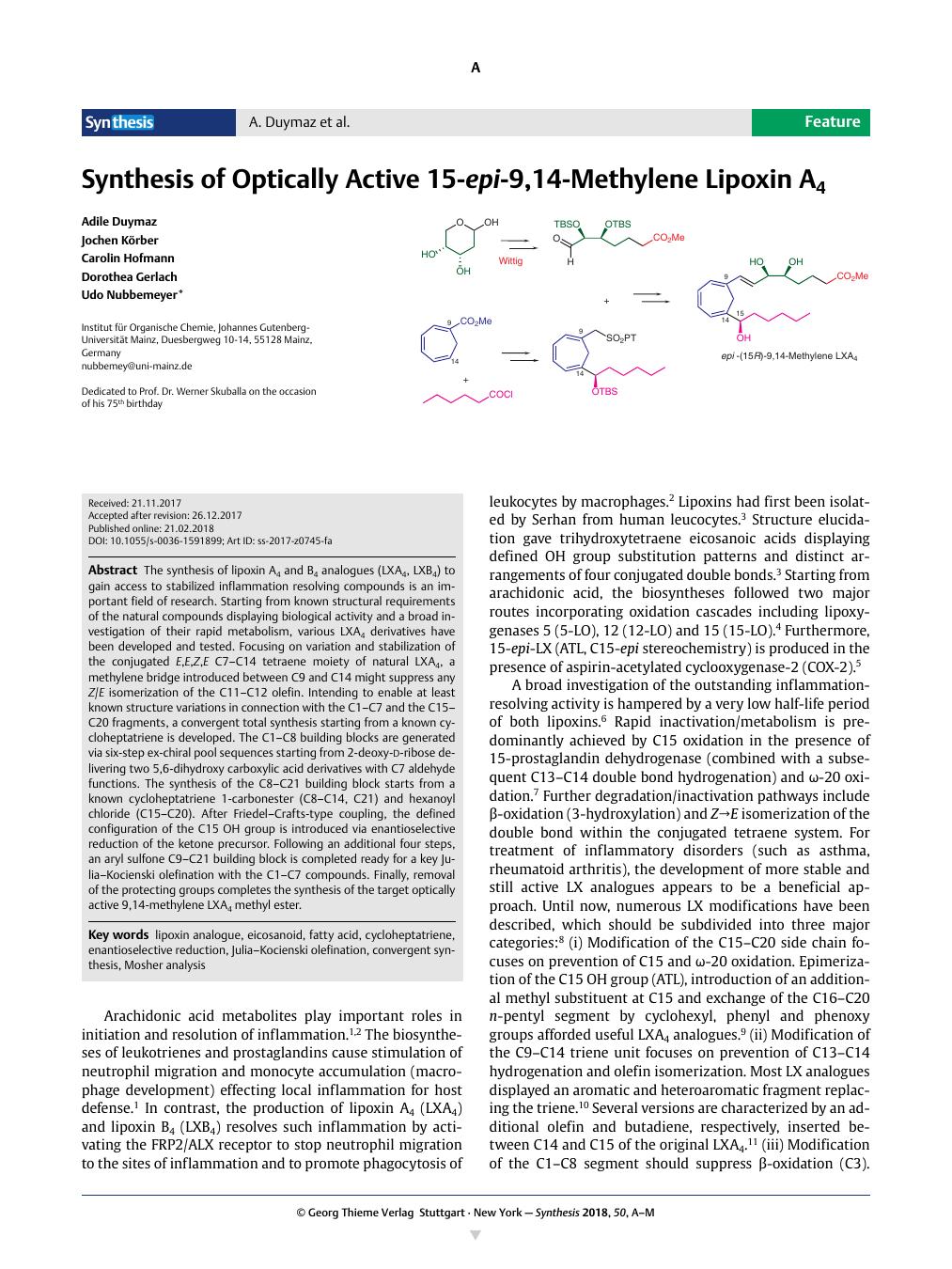Synthesis ( IF 2.2 ) Pub Date : 2018-02-21 , DOI: 10.1055/s-0036-1591899 Udo Nubbemeyer , Adile Duymaz , Jochen Körber , Carolin Hofmann , Dorothea Gerlach

|
Dedicated to Prof. Dr. Werner Skuballa on the occasion of his 75th birthday
Abstract
The synthesis of lipoxin A4 and B4 analogues (LXA4, LXB4) to gain access to stabilized inflammation resolving compounds is an important field of research. Starting from known structural requirements of the natural compounds displaying biological activity and a broad investigation of their rapid metabolism, various LXA4 derivatives have been developed and tested. Focusing on variation and stabilization of the conjugated E,E,Z,E C7–C14 tetraene moiety of natural LXA4, a methylene bridge introduced between C9 and C14 might suppress any Z/E isomerization of the C11–C12 olefin. Intending to enable at least known structure variations in connection with the C1–C7 and the C15–C20 fragments, a convergent total synthesis starting from a known cycloheptatriene is developed. The C1–C8 building blocks are generated via six-step ex-chiral pool sequences starting from 2-deoxy-d-ribose delivering two 5,6-dihydroxy carboxylic acid derivatives with C7 aldehyde functions. The synthesis of the C8–C21 building block starts from a known cycloheptatriene 1-carbonester (C8–C14, C21) and hexanoyl chloride (C15–C20). After Friedel–Crafts-type coupling, the defined configuration of the C15 OH group is introduced via enantioselective reduction of the ketone precursor. Following an additional four steps, an aryl sulfone C9–C21 building block is completed ready for a key Julia–Kocienski olefination with the C1–C7 compounds. Finally, removal of the protecting groups completes the synthesis of the target optically active 9,14-methylene LXA4 methyl ester.
The synthesis of lipoxin A4 and B4 analogues (LXA4, LXB4) to gain access to stabilized inflammation resolving compounds is an important field of research. Starting from known structural requirements of the natural compounds displaying biological activity and a broad investigation of their rapid metabolism, various LXA4 derivatives have been developed and tested. Focusing on variation and stabilization of the conjugated E,E,Z,E C7–C14 tetraene moiety of natural LXA4, a methylene bridge introduced between C9 and C14 might suppress any Z/E isomerization of the C11–C12 olefin. Intending to enable at least known structure variations in connection with the C1–C7 and the C15–C20 fragments, a convergent total synthesis starting from a known cycloheptatriene is developed. The C1–C8 building blocks are generated via six-step ex-chiral pool sequences starting from 2-deoxy-d-ribose delivering two 5,6-dihydroxy carboxylic acid derivatives with C7 aldehyde functions. The synthesis of the C8–C21 building block starts from a known cycloheptatriene 1-carbonester (C8–C14, C21) and hexanoyl chloride (C15–C20). After Friedel–Crafts-type coupling, the defined configuration of the C15 OH group is introduced via enantioselective reduction of the ketone precursor. Following an additional four steps, an aryl sulfone C9–C21 building block is completed ready for a key Julia–Kocienski olefination with the C1–C7 compounds. Finally, removal of the protecting groups completes the synthesis of the target optically active 9,14-methylene LXA4 methyl ester.
中文翻译:

光学活性的15-epi-9,14-亚甲基脂氧蛋白A4的合成
专用于沃纳Skuballa教授在他的75之际个生日
抽象的
合成脂蛋白A 4和B 4类似物(LXA 4,LXB 4)以获得稳定的消炎化合物是重要的研究领域。从表现出生物活性的天然化合物的已知结构要求开始,并对其快速代谢进行了广泛研究,已开发并测试了多种LXA 4衍生物。着眼于天然LXA 4的共轭E,E,Z,E C7–C14四烯部分的变异和稳定化,在C9和C14之间引入的亚甲基桥可能会抑制任何Z / EC11–C12烯烃的异构化。为了使至少已知的与C1-C7和C15-C20片段相关的结构变化,从已知的环庚三烯开始的聚合全合成方法得以开发。C1-C8结构单元是通过从2-deoxy- d开始的六步手性池序列生成的-核糖递送两个具有C7醛功能的5,6-二羟基羧酸衍生物。C8–C21结构单元的合成始于已知的环庚三烯1-碳酸酯(C8–C14,C21)和己酰氯(C15–C20)。在Friedel-Crafts型偶联之后,通过对映体选择性还原酮前体,引入C15 OH基团的确定构型。接下来的四个步骤完成了芳基砜C9–C21的结构单元,为关键的Julia–Kocienski与C1–C7化合物的烯烃制备做好了准备。最后,除去保护基团完成了目标旋光的9,14-亚甲基LXA 4甲酯的合成。
合成脂蛋白A 4和B 4类似物(LXA 4,LXB 4)以获得稳定的消炎化合物是重要的研究领域。从表现出生物活性的天然化合物的已知结构要求开始,并对其快速代谢进行了广泛研究,已开发并测试了多种LXA 4衍生物。着眼于天然LXA 4的共轭E,E,Z,E C7–C14四烯部分的变异和稳定化,在C9和C14之间引入的亚甲基桥可能会抑制任何Z / EC11–C12烯烃的异构化。为了使至少已知的与C1-C7和C15-C20片段相关的结构变化,从已知的环庚三烯开始的聚合全合成方法得以开发。C1-C8结构单元是通过从2-deoxy- d开始的六步手性池序列生成的-核糖递送两个具有C7醛功能的5,6-二羟基羧酸衍生物。C8–C21结构单元的合成始于已知的环庚三烯1-碳酸酯(C8–C14,C21)和己酰氯(C15–C20)。在Friedel-Crafts型偶联之后,通过对映体选择性还原酮前体,引入C15 OH基团的确定构型。接下来的四个步骤完成了芳基砜C9–C21的结构单元,为关键的Julia–Kocienski与C1–C7化合物的烯烃制备做好了准备。最后,除去保护基团完成了目标旋光的9,14-亚甲基LXA 4甲酯的合成。











































 京公网安备 11010802027423号
京公网安备 11010802027423号